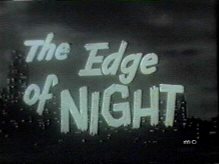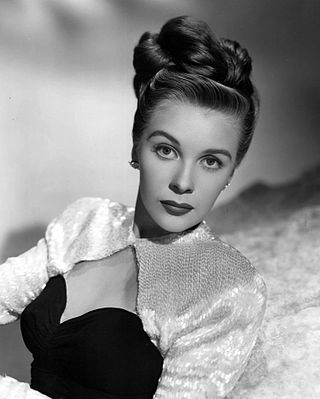Related Research Articles

The Edge of Night is an American mystery crime drama television series and soap opera, created by Irving Vendig and produced by Procter & Gamble Productions.

As the World Turns is an American television soap opera that aired on CBS for 54 years from April 2, 1956, to September 17, 2010. Irna Phillips created As the World Turns as a sister show to her other soap opera Guiding Light. With 13,763 hours of cumulative narrative, As the World Turns has the longest total running time of any television show. In terms of continuous run of production, As the World Turns at 54 years holds the fourth-longest run of any daytime network soap opera on American television, surpassed only by General Hospital, Guiding Light, and Days of Our Lives. As the World Turns was produced for its first 43 years in Manhattan and in Brooklyn from 2000 until 2010.

Charita Bauer was an American soap opera radio and television actress.

Mary Stuart was an American actress, guitarist, singer, and songwriter.

Lacey Amelia Turner is an English actress. With a career spanning two decades, she made her acting debut in the television soap opera EastEnders, in which she rose to prominence and has garnered critical acclaim for her portrayal of Stacey Slater, a character she initially played between 2004 and 2010 before returning in 2014.

Painted Dreams is an American radio soap opera that premiered on WGN radio, Chicago, on October 20, 1930 and last aired in July 1943. It is widely considered by scholars of the genre to be the first daytime soap opera or drama-by-installment serial. The first to be broadcast in daytime over a radio network would be Clara, Lu 'n Em, two years later.

Young Doctor Malone is an American soap opera, created by Irna Phillips, which had a long run on radio and television from 1939 to 1963. The producer was Betty Corday (1912–1987), who also produced Pepper Young's Family and later was a co-creator with husband Ted Corday of NBC Daytime's Days of Our Lives.

The Romance of Helen Trent was a radio soap opera which aired on CBS from October 30, 1933 to June 24, 1960 for a total of 7,222 episodes. The show was created by Frank and Anne Hummert, who were among the most prolific producers during the radio soap era.

Backstage Wife is an American soap opera radio program that details the travails of Mary Noble, a girl from a small town in Iowa who came to New York seeking her future.

Anne Hummert was the leading creator of daytime radio serials or soap opera dramas during the 1930s and 1940s, responsible for more than three dozen series.
Amanda of Honeymoon Hill is a 15-minute daily radio soap opera produced by Frank and Anne Hummert. Broadway actress Joy Hathaway had the title role, sometimes described as "the beauty of flaming red hair." The series was broadcast from February 5, 1940, until April 26, 1946, initially on the Blue Network at 3:15 p.m. until August 1942. It then moved to CBS, airing at 10:30 a.m. until 1943 when it was heard at 11 a.m.

Stella Dallas was an America radio soap opera that ran from October 25, 1937, to December 23, 1955. The New York Times described the title character as "the beautiful daughter of an impoverished farmhand who had married above her station in life." She was played for the entire run of the series by Anne Elstner. Her husband Stephen Dallas was portrayed at various times by Leo McCabe, Arthur Hughes and Frederick Tazere. Initially, Joy Hathaway played Stella's daughter Laurel with Vivian Smolen later taking over the role. Laurel's husband was Dick Grosvenor.

Our Gal Sunday is an American soap opera produced by Frank and Anne Hummert, network broadcast via CBS from March 29, 1937, to January 2, 1959, starring Dorothy Lowell and, after Lowell's 1944 death, Vivian Smolen in the title role.
Charles Robert Douglas Hardy Andrews was a novelist, screenwriter and radio drama scriptwriter.
Kitty Foyle is an American old-time radio and television soap opera originally aired during the 1940s and 1950s that was based on the 1940 film of the same name starring Ginger Rogers. Kitty Foyle was created by soap opera mogul Irna Phillips of Guiding Light fame and produced by daytime radio monarchs Frank and Anne Hummert of Helen Trent recognition. The program originally starred Julie Stevens in the title role of Kitty Foyle on radio. On television, the title role was portrayed by Kathleen Murray.
Edward Frank Hummert, Jr., professionally known as Frank Hummert and sometimes credited as E. Frank Hummert, was an American advertising agent originally but was best known for writing/producing episodes of nearly 100 daytime/primetime radio dramas and soap opera serials between the 1930s and the 1950s.

Florence Freeman was an actress in old-time radio. She was known as a "soap opera queen" for her work in daytime serial dramas.
The Carters of Elm Street is an American old-time radio soap opera. It was broadcast on NBC from February 13, 1939 to January 19, 1940 and on Mutual from January 22, 1940, to July 19, 1940

The Story of Mary Marlin is an American soap opera radio program. It was broadcast from October 3, 1934, until April 12, 1945, and returned from September 24, 1951, until April 11, 1952. After 1937 it was among the highest-rated soap operas. A version was also broadcast in Australia in 1959-1960.
References
- 1 2 Buxton, Frank and Owen, Bill (1972). The Big Broadcast: 1920–1950. The Viking Press. SBN 670-16240-x. P. 209.
- 1 2 Terrace, Vincent (1981), Radio's Golden Years: The Encyclopedia of Radio Programs 1930–1960. A.S. Barnes & Company, Inc. ISBN 0-498-02393-1. Pp. 234–235.
- 1 2 3 Cox, Jim (2005). Historical Dictionary of American Radio Soap Operas. Scarecrow Press, Inc. ISBN 0-8108-5323-X. Pp. 200–201.
- ↑ Sterling, Christopher H. (ed.) (2004). Encyclopedia of Radio. Fitzroy Dearborn. ISBN 1-57958-249-4. P.
- ↑ Connolly, Thomas F. "Helen Menken". Jewish Women's Archive. Retrieved 11 May 2014.
- ↑ McIver, Ernest D. Jr. (August 2, 1937). "'Round the Radio Dial". The Free Lance Star. Retrieved 11 May 2014.
- 1 2 3 "Tuesday's Highlights". Radio and Television Mirror. 12 (6): 44. October 1939. Retrieved 14 May 2014.
- ↑ Sher, Jack (July 4, 1937). "'Old Maid' on Marriage—From Experience". The Milwaukee Journal. Retrieved 11 May 2014.
- 1 2 Razlogova, Elena (2011). The Listener's Voice: Early Radio and the American Public. University of Pennsylvania Press. ISBN 978-0-8122-4320-8. P. 65.
- ↑ "Second Husband". Radio and Television Mirror. 13 (3): 12–14, 65–67. January 1940. Retrieved 14 May 2014.